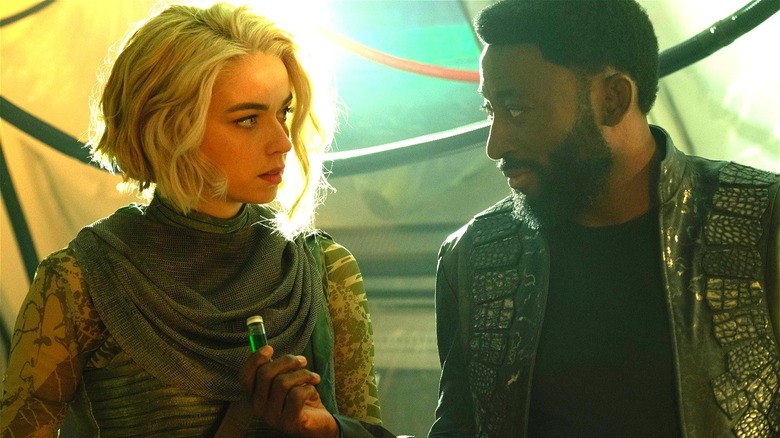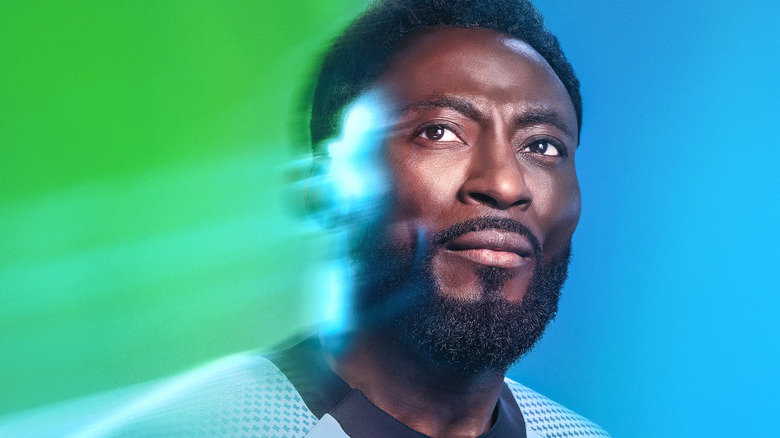Star Trek: Strange New Worlds Season 2 Levels The Playing Field Between Humans And Klingons
This post contains spoilers for the season 2 premiere of "Star Trek: Strange New Worlds."
Something that isn't too regularly talked about in the world of "Star Trek" is drug addiction. Addictive substances, it seems, aren't common in the 23rd or 24th centuries. When it comes to drinking, Starfleet officers are typically served synthehol, a form of alcohol that contains synthetic enzymes that enable the drinker to more rapidly metabolize the booze and walk away without feeling intoxicated. In one of the more infamous scenes in "Star Trek: The Next Generation," Wesley Crusher (Wil Wheaton) asks innocently why anyone would ever want to do drugs. The teenage character hasn't even heard of addiction. It wouldn't be until "Star Trek: Picard" in 2017 that Trekkies would see Raffi (Michelle Hurd) smoking a vape pen and then, later, taking some sort of addictive narcotic that one sprays directly into their eyeball.
Given the level of technology in "Star Trek," it stands to reason that illegal drugs have, in fact, become more specific and powerful than they are today. Addiction may not exist in Starfleet, but there are a host of other worlds that live far away from the purview of the Federation. Raffi's eyeball drugs are likely only one of many street-level narcotics that "Star Trek" rarely sees, mainly because the bulk of "Star Trek" is confined to Starfleet vessels and space stations.
This likely also holds true for performance-enhancing drugs. By the 2200s, surely one can take a quick hypospray to the neck and temporarily be filled with great strength, enhanced speed, and agility. Indeed, that happens in "The Broken Circle," the first episode of the second season of "Star Trek: Strange New Worlds." It seems Dr. M'Benga (Babs Olusanmokun) and Nurse Chapel (Jess Bush) carry a shot of kung fu drugs in case of emergencies.
Kung fu drugs?
In "The Broken Circle," Dr. M'Benga and Nurse Chapel have trekked to a distant planet to locate their compatriot, Lieutenant Noonien-Singh (Christina Chong). She has been looking after a young girl on a planet of both Klingon and human refugees and finds herself surrounded by suspicion and danger. In one scene, the doctor and nurse are trapped in a desperate scenario and surrounded by much stronger and more vicious Klingons. When it seems that they will not be able to give their Klingon pursuers the slip, Dr. M'Benga whips out a vial of mysterious green fluid. Both he and Nurse Chapel know what it is, although they don't bother explaining for the benefit of the show's viewers. They give themselves injections, and, for a few moments, become fast-moving kung-fu machines that handily beat their attackers.
What was that drug? And — perhaps an important question — is it standard Starfleet issue? Klingons, it's worth noting, are regularly described on "Star Trek" as being much stronger and much better fighters than any of their human opponents; it is considered foolhardy for a non-Klingon to engage in hand-to-hand combat with them. "Strange New Worlds" takes place shortly after the end of a brief but devastating war with the Klingons, so relations are not exactly rosy between the Empire and anyone who serves on board a Federation starship. This would mean that Starfleet officers would enter the world wary of Klingons and their tendency to fight.
It seems that in a post-war malaise, otherwise peaceful medical officers may require a chemical advantage, should they find themselves unexpectedly in a combat scenario. When living in uneasy times, one can kind of see why Dr. M'Benga might use a kung fu injection.
The ethics of post-war malaise
No matter how you slice it, however, this kind of "rage drug" seems like it would be massively unethical to issue to Starfleet officers. It's easy to see why.
The actual parameters of the drug, or even its name, are not revealed in "The Broken Circle," so the audience can't know just how in control Nurse Chapel and Dr. M'Benga are of their bodies. When hopped up on violence drugs, are they still able to tell the difference between right and wrong? And should officers have access to one additional tool of violence (already in addition to their personal phasers) when Starfleet typically lives by a code of diplomacy? In post-war times, one can imagine any number of potentially violent scenarios on any number of desperate worlds, but one might also think that Starfleet wouldn't ever want to commit acts of violence and risk the peace that was just recently attained.
Indeed, even on a battlefield, the idea of keeping soldiers high on drugs is an immoral mess that "Star Trek" has openly criticized in the past. In the "Star Trek: The Next Generation" episode "Encounter at Farpoint," Q (John De Lancie) pointed out that humans once had an army (in our near future, but Trek's distant past) held in line by deliberately inflicted drug addiction. There was also an ongoing subplot on "Star Trek: Deep Space Nine" about how the military force called the Jem'Hadar has been genetically altered to require a drug called Ketracel White. This act — drug-enhanced military violence — is a mortal sin in the secular world of "Star Trek."
One might hope that the drug is addressed in a future episode of "Strange New Worlds." It seems a can of worms has been opened.


